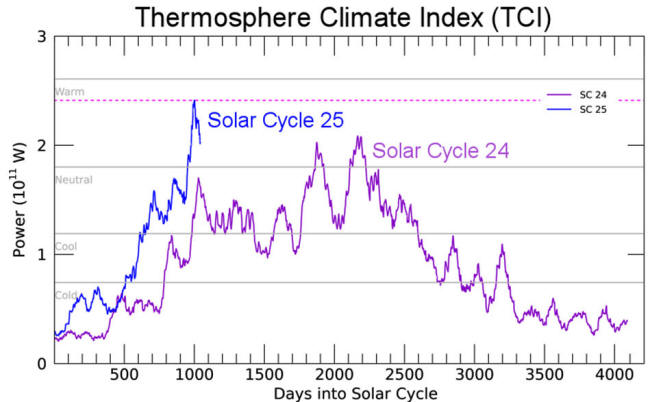|
June 03, 2023 from SpaceWeather Website
A severe geomagnetic storm on March 24, 2023, photographed by Michael Underwood from Yellowstone National Park
If you're 'a satellite,' this story is important...
A series of geomagnetic solar storms in 2023 has pumped terawatts of energy into Earth's upper atmosphere, helping to push its temperature and height to a 20-year high.
Air surrounding our planet is now touching satellites in Earth orbit and dragging them down.
Martin Mlynczak is an expert on the temperature up there.
For 20 years he has been using the SABER instrument on NASA's TIMED satellite to monitor infrared emissions from "the thermosphere," the uppermost layer of the atmosphere.
The thermosphere is exquisitely sensitive to solar activity, readily absorbing energy from solar flares and geomagnetic storms.
These storms have been coming hard and fast with the recent rise of Solar Cycle 25.
The parenthetical values are TeraWatts (1,000,000,000,000 Watts) of infrared power observed by SABER during each storm.
The sensor obtains these
numbers by measuring infrared radiation emitted from nitric oxide
and carbon dioxide molecules in the thermosphere.
tracks thermal energy in Earth's upper atmosphere. So far, Solar Cycle 25 is far ahead of Solar Cycle 24. Credit: Linda Hunt
Actually, it doesn't take a strong storm to cause problems...
In Feb. 2022, a minor geomagnetic storm dumped enough heat into the thermosphere that 38 newly launched Starlink satellites fell out of the sky.
SpaceX has since started
launching their Starlinks to higher initial altitudes to avoid the
drag.
The growing constellation of 4100 Starlinks now provides internet service to more than a million customers.
An extreme geomagnetic
storm like the
Halloween Storms of 2003 could
shift the positions of these satellites by many 10s of kilometers,
increasing the risk of collisions and causing some of the lowest
ones to de-orbit...
|



